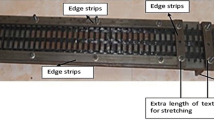Abstract
This article addresses the influence of the addition of short dispersed and short integral fibres made of alkali-resistant (AR) glass on the fracture behaviour of textile-reinforced concrete (TRC) subject to tensile loading. A series of uniaxial, deformation-controlled tension tests was performed to study the strength, deformation, and fracture behaviour of thin, narrow plates made of TRC, both with and without the addition of short fibres. Additionally, uniaxial tension tests on specimens reinforced with only short fibres were performed to figure out the difference in behaviour in the absence of textile reinforcement. Furthermore, multifilament-yarn and single-fibre pullout tests were carried out to gain a better understanding of bonding properties and crack-bridging behaviour. While pronounced enhancement of first-crack stress was achieved due to the addition of short dispersed fibres (the value increased by a factor of 2), a significant improvement in tensile strength was recorded for TRC specimens with the addition of integral glass fibres; the value increased by approximately 30 %. Moreover, TRC specimens reinforced with short dispersed glass fibres showed formation of more and finer cracks in comparison to the specimens with integral fibres. It was also found that short integral fibres can improve the bond between multifilament-yarns and the surrounding matrix by means of “special” cross-links. In TRC with short dispersed fibres this phenomenon was less pronounced. The investigations were accompanied by microscopical investigations which provided additional basis for an in-depth discussion of the decisive working mechanisms of hybrid reinforcement.


















Similar content being viewed by others
References
Barhum R, Mechtcherine V (2012) Effect of short, dispersed glass and carbon fibres on the behaviour of textile-reinforced concrete under tensile loading. Eng Fract Mech. doi:10.1016/j.engfracmech.2012.06.001
Bartos P (2011) Environmentally active GRC: towards better appearance of concrete and a reduction of air-pollution in urban environment. Nanotechnology in construction, N: 2. Nanobuild.ru, pp 24–39
Brameshuber W (2006) Textile Reinforced Concrete: State of the Art Report (36) of RILEM Technical Committee 201: Textile Reinforced Concrete, RILEM Publications, SARL
Butler M, Hempel R, Schiekel M (2006) The influence of short glass fibres on the working capacity of textile reinforced concrete. In: Hegger J, Brameshuber W, Will N (eds) Textile reinforced concrete: Proceedings of the 1st International RILEM conference, Aachen, pp 45–54
Butler M, Mechtcherine V, Hempel S (2010) Durability of textile reinforced concrete made with AR glass fibre: effect of the matrix composition. Mater Struct 43:1351–1368
Butler M, Hempel S, Mechtcherine V (2011) Modelling of ageing effects on crack-bridging behaviour of AR-glass multifilament yarns embedded in cement-based matrix. Cem Concr Res 41:403–411
Colombo I, Colombo M, Magri A, Zani G, Di Prisco M (2011) Tensile behaviour of textile: influence of multilayer reinforcement. In: Parra-Montesinos GJ, Reinhardt HW, Naaman AE (eds) 6th International workshop on high performance fiber reinforced cement composites (HPFRCC 6), Ann Arbor, pp 463–470
Curbach M, Jesse F (2009) Textile reinforced structures. Proceedings of the 4th colloquium on textile reinforced structures (CTRS4), Dresden
Hartig J, Häußler-Combe U, Schicktanz K (2008) Influence of bond properties on the tensile behaviour of textile reinforced concrete. Cem Concr Compos 30:898–906
Hegger J, Aldea C, Brameshuber W, Curbach M (2006) Application of textile reinforced concrete. In: Brameshuber W (ed) State of the Art Report (36) of RILEM Technical Committee 201: Textile Reinforced Concrete, RILEM publications SARL, pp 237–270
Hinzen M, Brameshuber W (2009) Improvement of serviceability and strength of Textile Reinforced Concrete by using short fibres. In: Curbach M, Jesse F (eds) Textile reinforced structures. Proceedings of the 4th colloquium on textile reinforced structures (CTRS4), Dresden, pp 261–272
Jesse F (2004) Tragverhalten von Filamentgarnen in zementgebundener Matrix. Technische Universität Dresden, Dissertation
Jun P, Mechtcherine V (2010) Behaviour of strain-hardening cement-based composites (SHCC) under monotonic and cyclic tensile loading. Part 1: Experimental investigations. Cem Concr Compos 32:801–809
Kabele P, Novak L, Nemecek J, Kopecky L (2006) Effects of chemical exposure on bond between synthetic fibre and cementitious matrix. In: Hegger J, Brameshuber W, Will N (eds) Textile reinforced concrete. Proceedings of the 1st international RILEM conference, Aachen, pp 91–99
Li V, Wang Y, Baker S (1990) Effect of inclining angle, bundling and surface treatment on synthetic fibre pullout from a cement matrix. Composites 21:132–140
Lorenz E, Ortlepp R (2011) Bond behavior of textile reinforcements: development of a pull-out test and modeling of the respective bond versus slip relation. In: Parra-Montesinos GJ, Reinhardt HW, Naaman AE (eds) 6th International work shop on high performance fiber reinforced cement composites (HPFRCC 6), Ann Arbor, pp 479–486
Majumdar AJ, Laws V (1991) Glass fibre reinforced concrete. BSP professional books, Oxford
Mechtcherine V (2012) Towards a durability framework for structural elements and structures made of or strengthened with high-performance fibre-reinforced composites. Constr Build Mater 31:94–104
Silva FA, Butler M, Mechtcherine V, Zhu D, Mobasher B (2011) Strain rate effect on the tensile behaviour of Textile-reinforced concrete under static and dynamic loading. Mater Sci Eng A 528:1727–1734
Acknowledgments
This project was initiated in the Collaborative Research Centre SFB 528 “Textile Reinforcement for Structural Strengthening and Retrofitting” financed by the German Research Foundation (DFG). The authors would like to acknowledge with gratitude the foundation’s financial support.
Author information
Authors and Affiliations
Corresponding author
Rights and permissions
About this article
Cite this article
Barhum, R., Mechtcherine, V. Influence of short dispersed and short integral glass fibres on the mechanical behaviour of textile-reinforced concrete. Mater Struct 46, 557–572 (2013). https://doi.org/10.1617/s11527-012-9913-3
Received:
Accepted:
Published:
Issue Date:
DOI: https://doi.org/10.1617/s11527-012-9913-3




